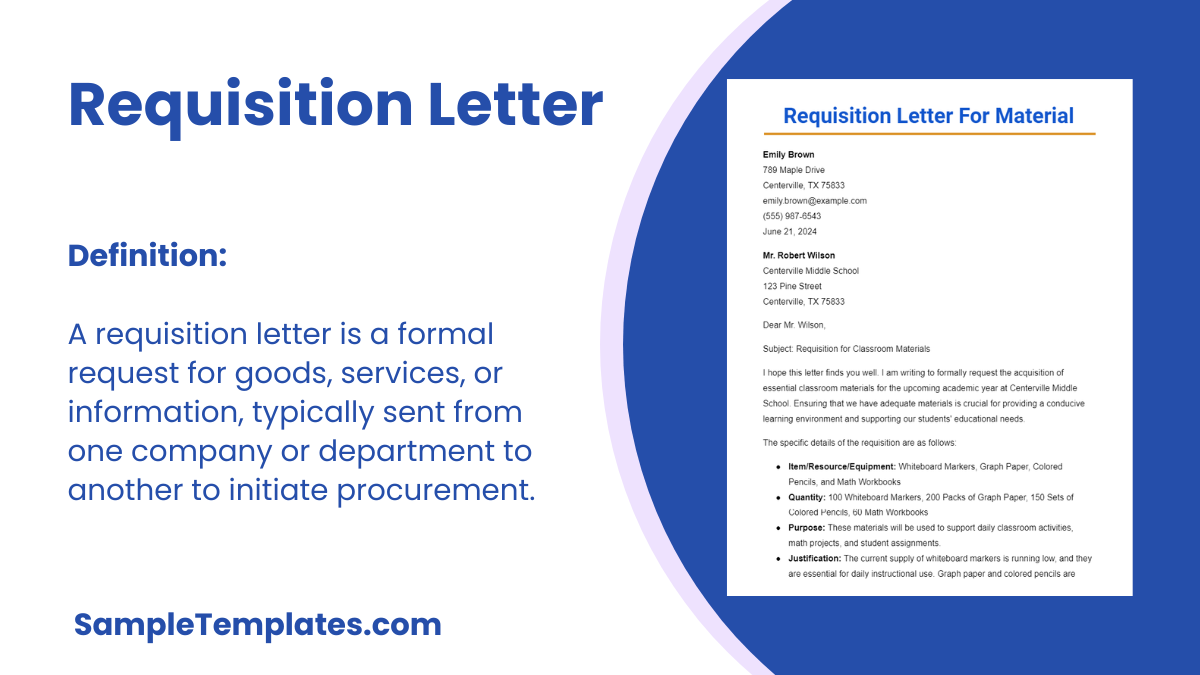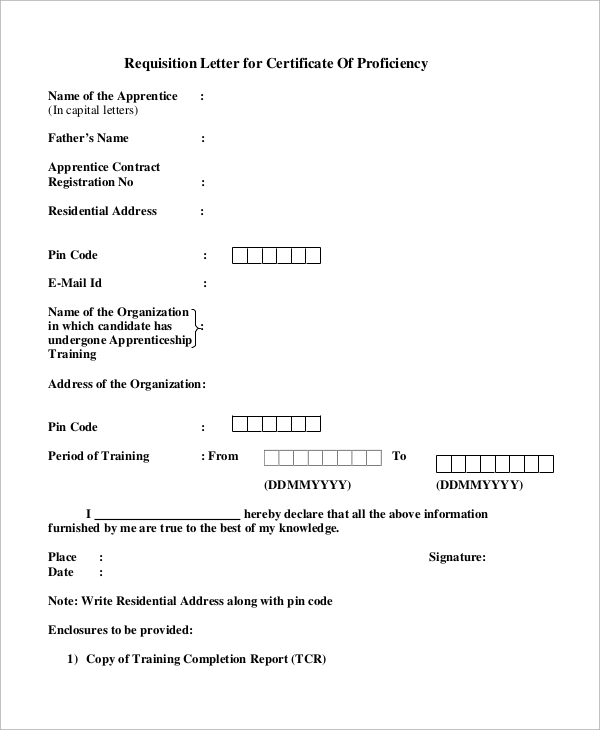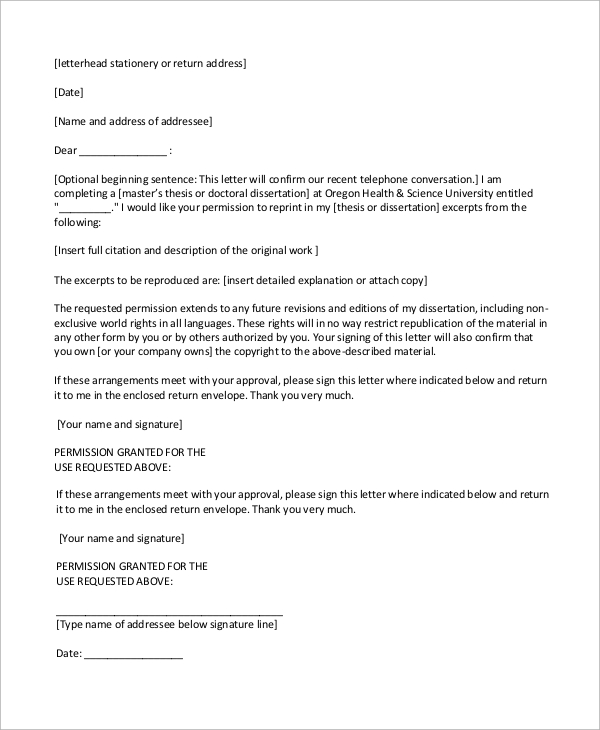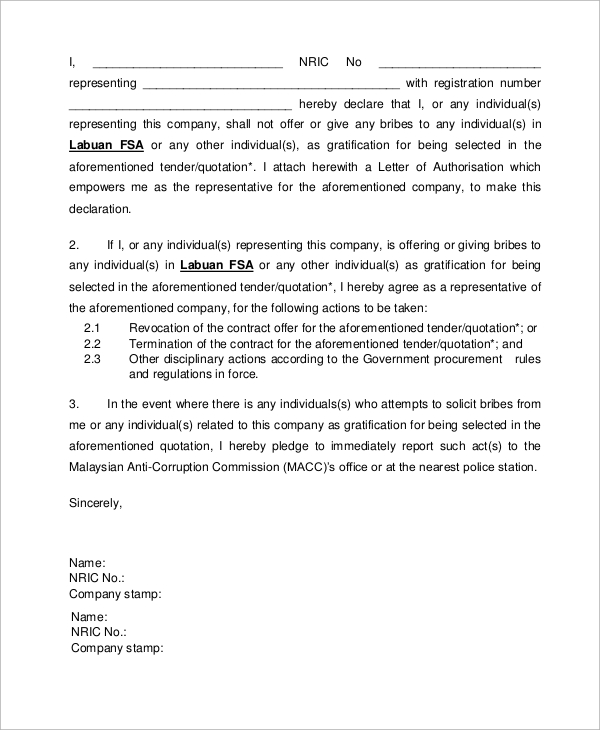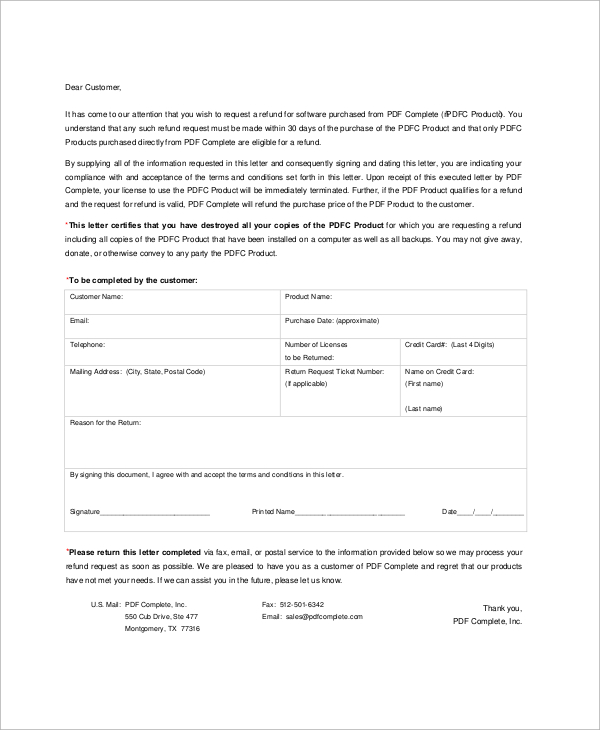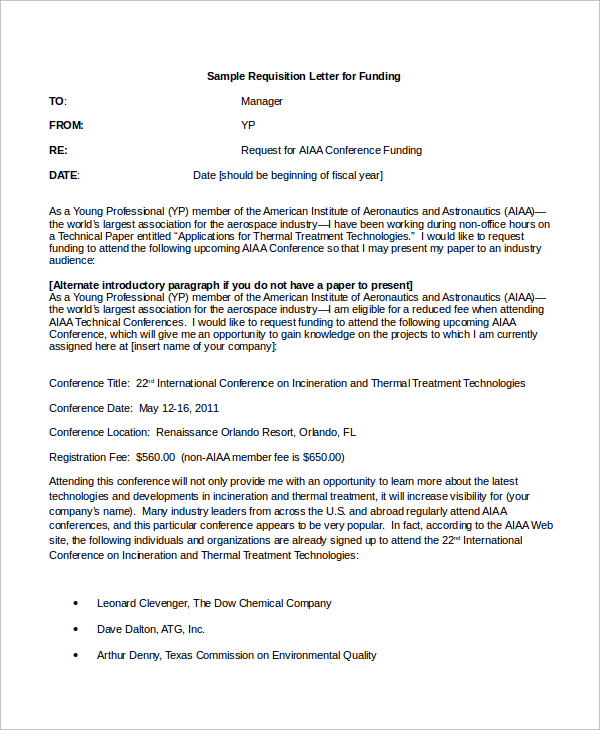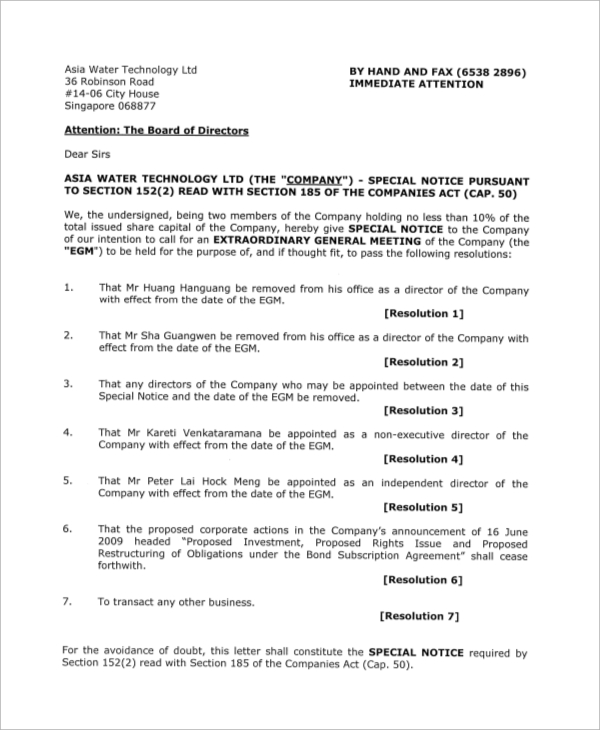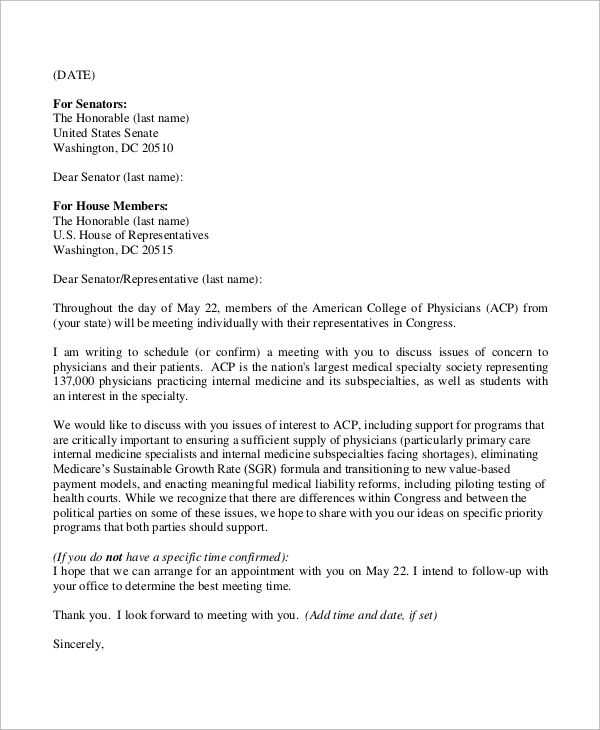When someone wants to ask for something or orders a particular action to be performed, a requisition letter is usually given to that person or individual who has been asked to perform a certain act or the procurement of some object necessary to complete one’s job. Thus, requisition Sample Letters are a formal way to request for the availability of goods and services that would help the organization. Here’s a list of requisition letters.
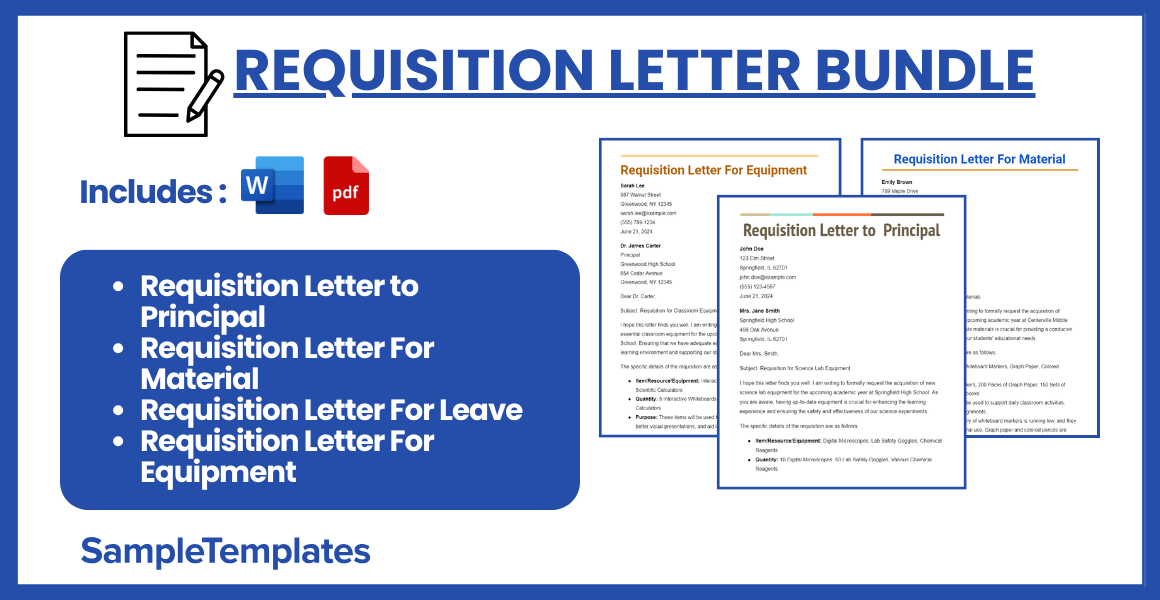
Download Requisition Letter Bundle
Requisition Letter to Principal
John Doe
123 Elm Street
Springfield, IL 62701
[email protected]
(555) 123-4567
June 21, 2024
Mrs. Jane Smith
Springfield High School
456 Oak Avenue
Springfield, IL 62701
Dear Mrs. Smith,
Subject: Requisition for Science Lab Equipment
I hope this letter finds you well. I am writing to formally request the acquisition of new science lab equipment for the upcoming academic year at Springfield High School. As you are aware, having up-to-date equipment is crucial for enhancing the learning experience and ensuring the safety and effectiveness of our science experiments.
The specific details of the requisition are as follows:
- Item/Resource/Equipment: Digital Microscopes, Lab Safety Goggles, Chemical Reagents
- Quantity: 10 Digital Microscopes, 50 Lab Safety Goggles, Various Chemical Reagents
- Purpose: The equipment will be used in our biology and chemistry classes to provide students with hands-on learning experiences and to ensure their safety during experiments.
- Justification: The current microscopes are outdated and often malfunction, hindering students’ ability to observe microscopic organisms. The new digital microscopes will allow students to capture and analyze images more effectively. Additionally, the current stock of lab safety goggles is insufficient for the growing number of students, and the chemical reagents are necessary for conducting a broader range of experiments safely.
I believe that the procurement of this equipment will significantly contribute to better learning outcomes, increased student engagement, and improved safety in our science labs.
I am hopeful that you will consider this request favorably and grant approval at the earliest convenience. Should you require any additional information or wish to discuss this further, please do not hesitate to contact me.
Thank you for your attention to this matter. I look forward to your positive response.
Yours sincerely,
John Doe
Science Teacher
Springfield High School
[email protected]
(555) 123-4567
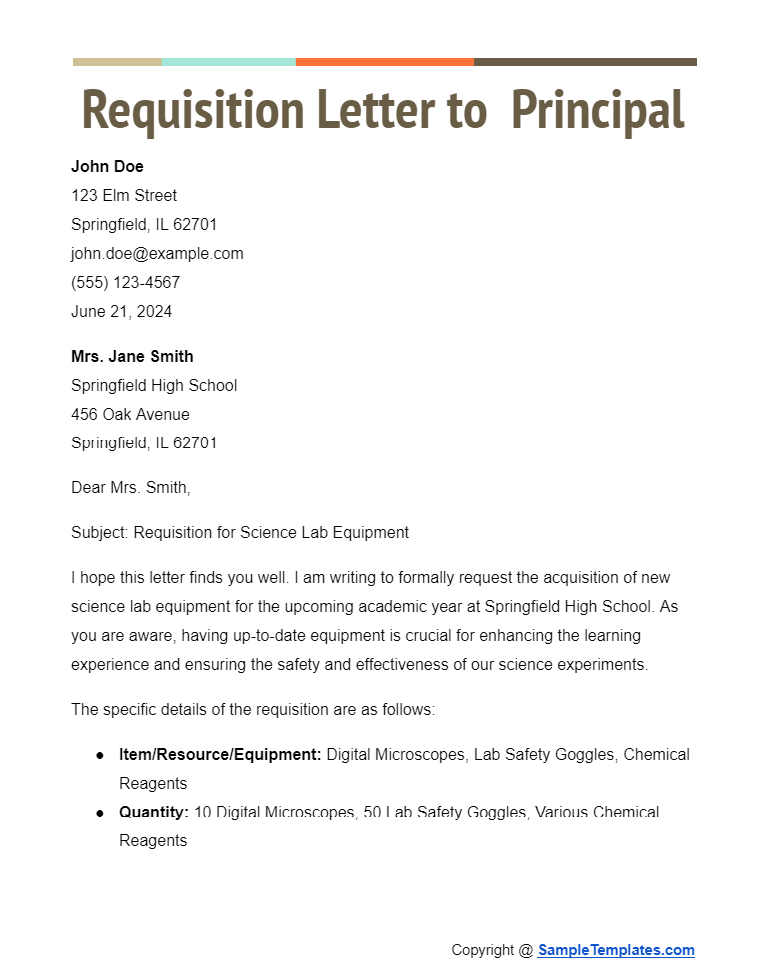
Requisition Letter For Material
Emily Brown
789 Maple Drive
Centerville, TX 75833
[email protected]
(555) 987-6543
June 21, 2024
Mr. Robert Wilson
Centerville Middle School
123 Pine Street
Centerville, TX 75833
Dear Mr. Wilson,
Subject: Requisition for Classroom Materials
I hope this letter finds you well. I am writing to formally request the acquisition of essential classroom materials for the upcoming academic year at Centerville Middle School. Ensuring that we have adequate materials is crucial for providing a conducive learning environment and supporting our students’ educational needs.
The specific details of the requisition are as follows:
- Item/Resource/Equipment: Whiteboard Markers, Graph Paper, Colored Pencils, and Math Workbooks
- Quantity: 100 Whiteboard Markers, 200 Packs of Graph Paper, 150 Sets of Colored Pencils, 60 Math Workbooks
- Purpose: These materials will be used to support daily classroom activities, math projects, and student assignments.
- Justification: The current supply of whiteboard markers is running low, and they are essential for daily instructional use. Graph paper and colored pencils are needed for math projects and geometry assignments. New math workbooks will provide students with updated exercises and practice problems, which are critical for mastering the curriculum.
I believe that the procurement of these materials will significantly contribute to better learning outcomes, increased student engagement, and overall academic success.
I am hopeful that you will consider this request favorably and grant approval at the earliest convenience. Should you require any additional information or wish to discuss this further, please do not hesitate to contact me.
Thank you for your attention to this matter. I look forward to your positive response.
Yours sincerely,
Emily Brown
Math Teacher
Centerville Middle School
[email protected]
(555) 987-6543
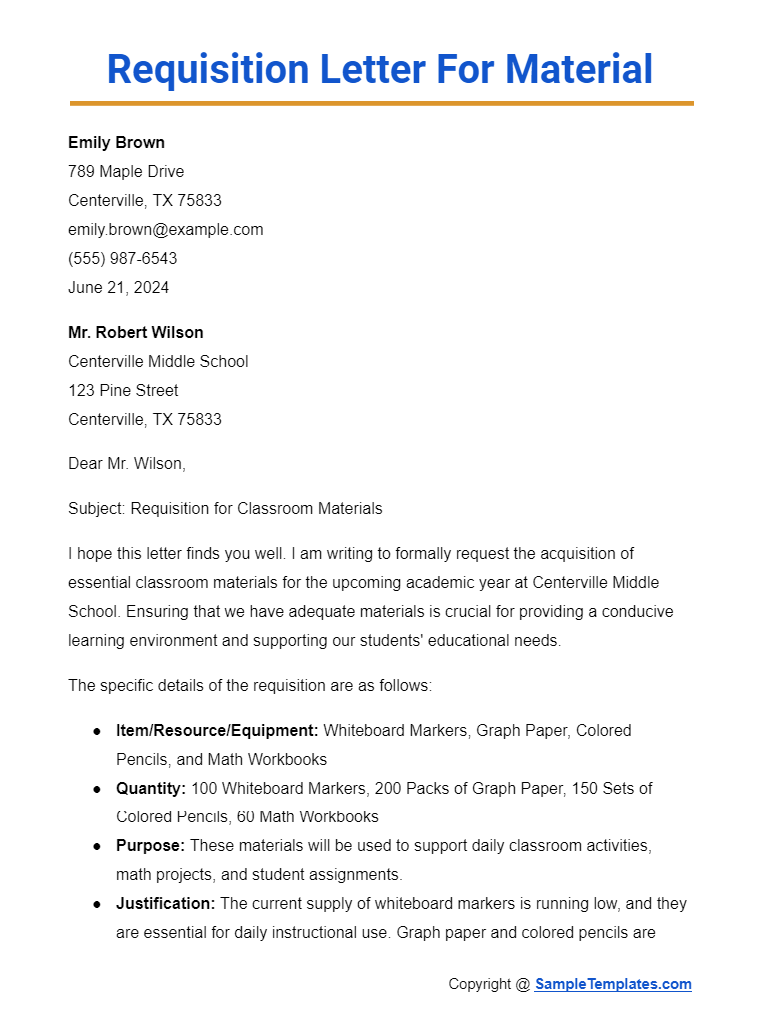
Requisition Letter For Leave
Michael Johnson
456 Birch Lane
Riverside, CA 92501
[email protected]
(555) 654-3210
June 21, 2024
Ms. Sarah Thompson
Principal
Riverside High School
789 Oak Street
Riverside, CA 92501
Dear Ms. Thompson,
Subject: Request for Leave of Absence
I hope this letter finds you well. I am writing to formally request a leave of absence from my position as an English Teacher at Riverside High School. I am requesting leave for personal reasons and would like to be away from work from July 10, 2024, to July 24, 2024.
The reason for this leave is due to a family medical emergency that requires my immediate attention. I assure you that I have made arrangements to ensure that my responsibilities will be managed during my absence. Mr. David Miller has kindly agreed to cover my classes and responsibilities during this period.
I have attached the necessary documentation to support my leave request. I will also be available via email or phone should any urgent matters arise that require my attention.
I believe this leave will allow me to handle my personal matters effectively and return to my duties with renewed energy and focus. I kindly request your understanding and approval for this leave of absence.
Thank you for considering my request. I look forward to your positive response.
Yours sincerely,
Michael Johnson
English Teacher
Riverside High School
[email protected]
(555) 654-3210
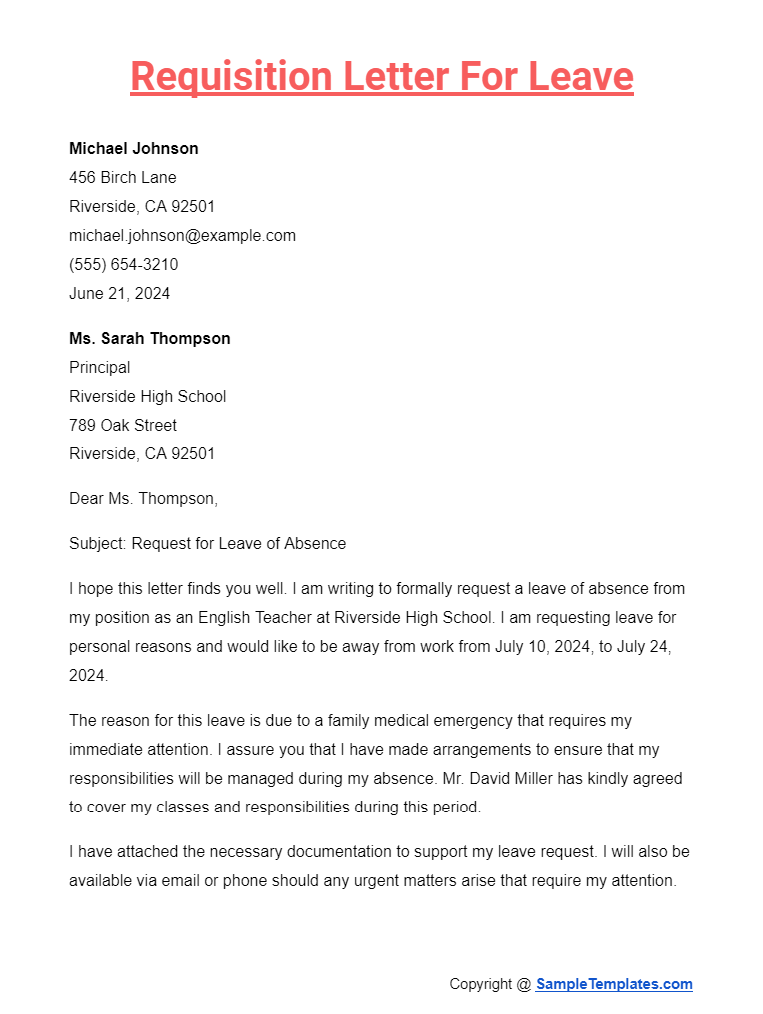
Requisition Letter For Equipment
Sarah Lee
987 Walnut Street
Greenwood, NY 12345
[email protected]
(555) 789-1234
June 21, 2024
Dr. James Carter
Principal
Greenwood High School
654 Cedar Avenue
Greenwood, NY 12345
Dear Dr. Carter,
Subject: Requisition for Classroom Equipment
I hope this letter finds you well. I am writing to formally request the acquisition of essential classroom equipment for the upcoming academic year at Greenwood High School. Ensuring that we have adequate equipment is crucial for providing a conducive learning environment and supporting our students’ educational needs.
The specific details of the requisition are as follows:
- Item/Resource/Equipment: Interactive Whiteboards, Document Cameras, Scientific Calculators
- Quantity: 5 Interactive Whiteboards, 5 Document Cameras, 30 Scientific Calculators
- Purpose: These items will be used to enhance classroom instruction, facilitate better visual presentations, and aid in complex mathematical computations.
- Justification: The current whiteboards are outdated and do not support interactive learning. Document cameras will allow for better display of documents and objects during lessons. Scientific calculators are essential for higher-level math courses, and our current supply is insufficient for the number of students enrolled.
I believe that the procurement of this equipment will significantly contribute to better learning outcomes, increased student engagement, and overall academic success.
I am hopeful that you will consider this request favorably and grant approval at the earliest convenience. Should you require any additional information or wish to discuss this further, please do not hesitate to contact me.
Thank you for your attention to this matter. I look forward to your positive response.
Yours sincerely,
Sarah Lee
Mathematics Teacher
Greenwood High School
[email protected]
(555) 789-1234
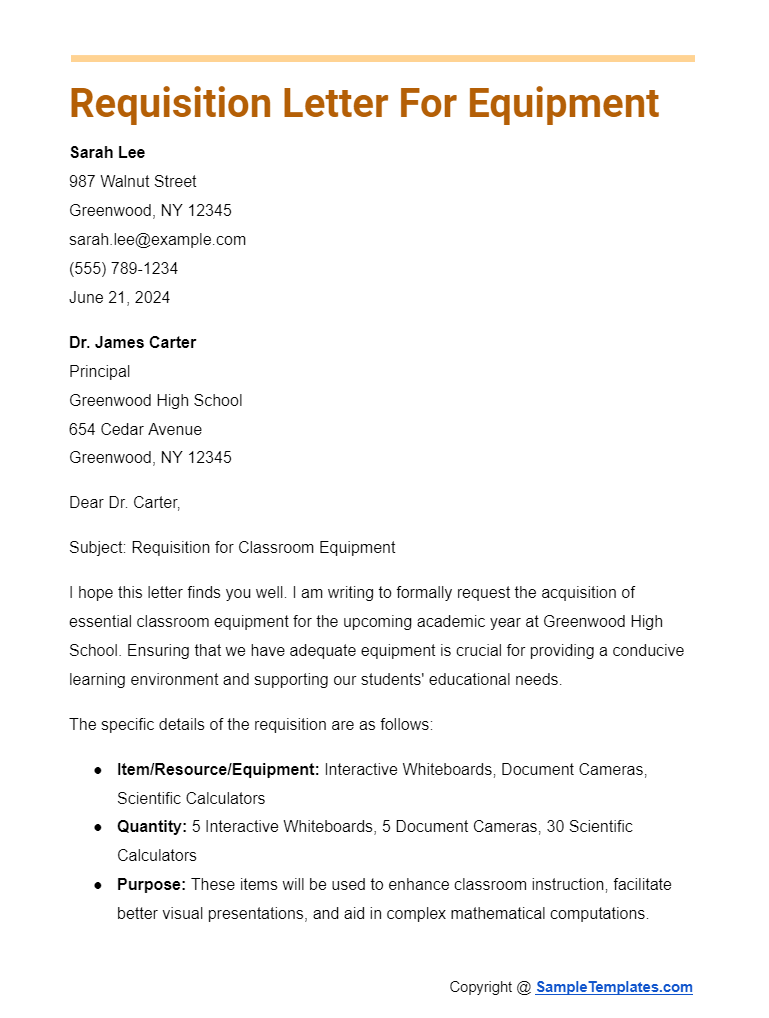
Browse More Templates On Requisition Letter
1. Requisition Letter for Job Template
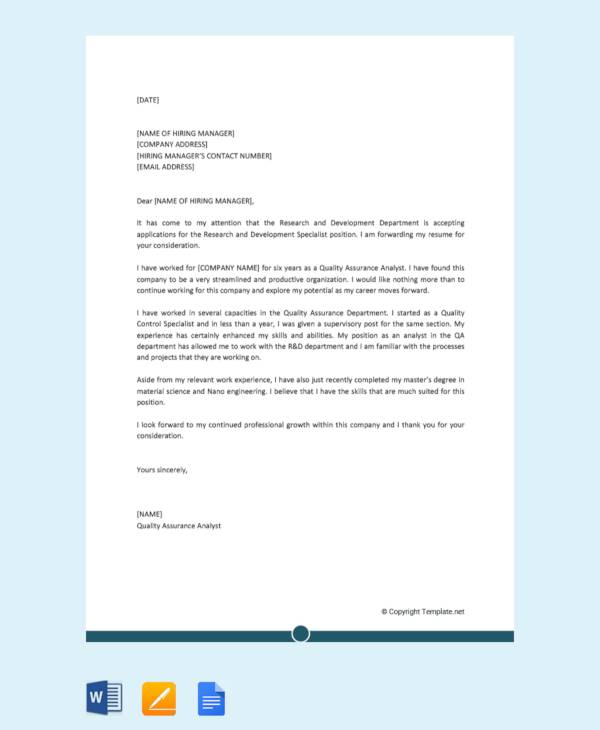
2. Requisition Letter for Office Equipment Template
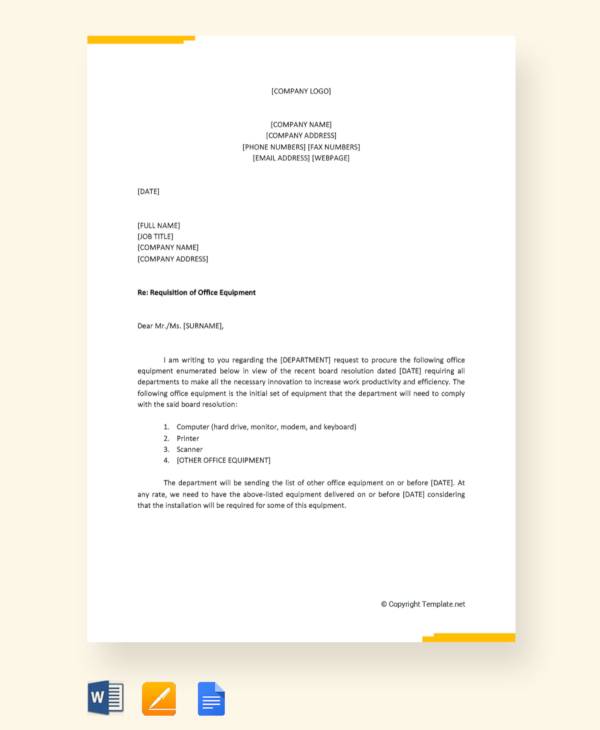
3. Requisition Letter Template
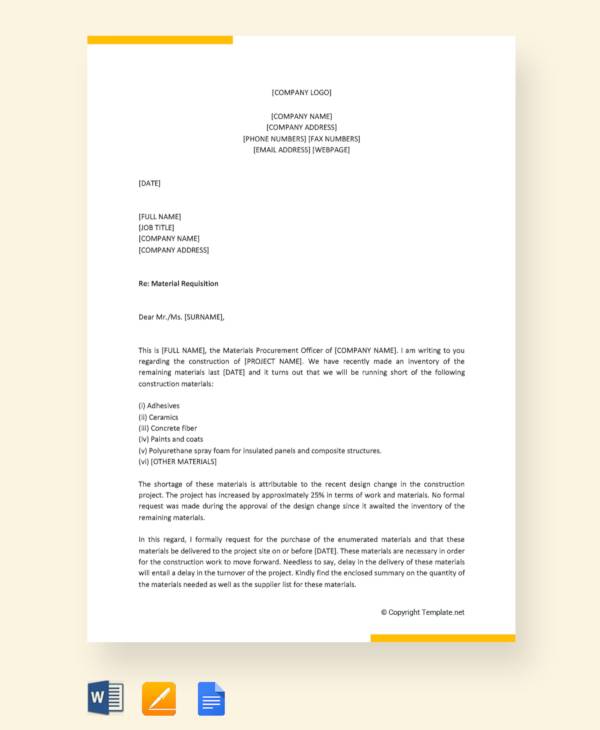
4. Requisition Letter for Certificate of Proficiency
When a sample certificate of proficiency is asked for, a requisition letter is sent asking for the same. It contains the need and the necessity to have the certificate of proficiency.
What is a letter of requisition?
A letter of requisition is a formal document used to request goods, services, or information from a particular source. It is a written communication that Sample outlines the specific items or resources needed, along with relevant details such as quantity, specifications, and delivery expectations. The letter serves as an official request and facilitates the process of fulfilling the requirements outlined within it.
Key Components of a Letter of Requisition:
- Sender’s Information:
- The letter typically begins with the sender’s details, including name, title, department, and contact information.
- Date:
- The date of the letter is important for record-keeping and establishing a sample timeline for the requested items.
- Recipient’s Information:
- Clearly state the details of the recipient, including the individual or department responsible for fulfilling the requisition.
- Salutation:
- Begin the letter with a formal salutation, addressing the recipient respectfully.
- Introduction:
- Provide a sample brief introduction, explaining the purpose of the letter and the context for the requisition.
- Details of the Requisition:
- Clearly outline the items or services being requested. Include specifics such as quantity, specifications, and any other relevant details.
- Justification:
- Include a justification for the requisition, explaining why the requested items are necessary and how they contribute to the goals or operations of the requesting party.
- Urgency or Timeline:
- If applicable, indicate the urgency of the requisition and any specific timelines or deadlines that need to be met.
- Delivery Instructions:
- Provide instructions regarding the preferred method of delivery, location, or any other relevant logistics.
- Closing:
- Conclude the letter with a formal closing, expressing gratitude and providing contact information for further communication.
- Signature:
- Include the sender’s signature to authenticate the requisition.
5. Vehicle Purchase Approval Requisition Letter
When a vehicle is purchased, approval or permit regarding its license number is needed from the governing authority. Such a requisition letter thus asks for the approval to be issued.
6. Sample Permission Requisition Letter Format
When a copyrighted material needs to be printed in the context of a fictional or a non-fictional work, a requisition letter is composed to seek permission for reprinting copyrighted material.
Usage of Requisition Letters
Requisition letters are of great use, as shown by the above-mentioned sample templates. When you need to ask for anything, seek information or procuring permission or a particular object, a letter format of the requisition is written to ask the competent authorities to get the desired action or object from them.
They are a formal way to ask for a particular action to be taken or for getting permission for conducting an action of your own done with intent. You can also see the Sample Offer Letters.
7. Office Supplies Stationery Requisition Letter
When office stationery runs low, a letter of the requisition is usually written to the suppliers of stationery requesting new stationery to be supplied to the office of the concerned enterprise.
Why is a Requisition Letter important?
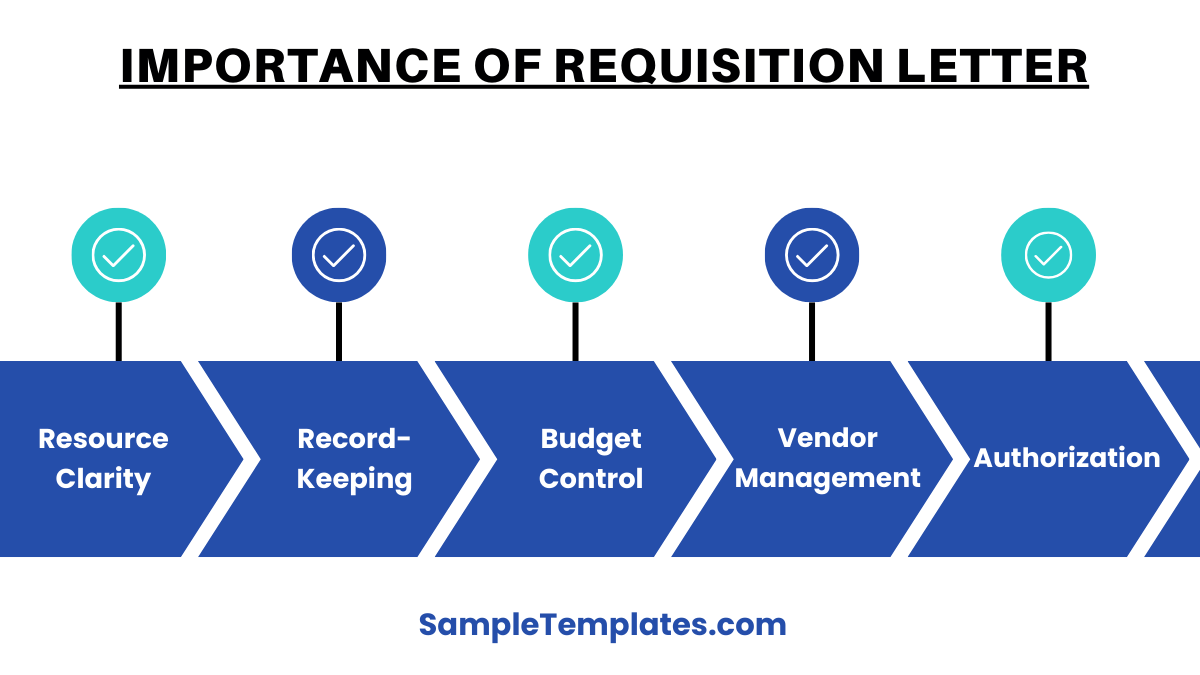
A Requisition Letter holds paramount importance in the organizational context, serving as a formalized communication tool that facilitates the procurement of essential items, services, or actions. The significance of a Requisition Letter lies in its ability to streamline internal processes, enhance transparency, and contribute to efficient resource management within an organization.
1. Streamlining Procurement Processes: A Requisition Letter acts as a structured request for specific resources or services. It serves as the initial step in the procurement process, providing a clear and documented outline of what is needed. This clarity is crucial for the purchasing department to source the required items promptly.
2. Clarity in Resource Needs: By detailing the items, quantities, and specifications needed, a Requisition Letter eliminates ambiguity. This clarity ensures that the procurement team understands the exact requirements, reducing the likelihood of errors or misunderstandings during the purchasing process.
3. Documentation and Record-Keeping: A Requisition Letter serves as a formal record of resource needs. This process documentation is valuable for internal audits, compliance requirements, and future reference. It creates a comprehensive history of resource requests, aiding in accountability and decision-making.
4. Authorization and Approval: A Requisition Letter often goes through an authorization and approval process. This ensures that requests align with budgetary constraints, organizational priorities, and compliance standards. Authorization adds a layer of control and accountability to the procurement process.
5. Budgetary Control: By requiring approval before procurement, a Requisition Letter contributes to effective budgetary control. Decision-makers can assess the financial implications of the requested resources and make informed decisions based on the available budget.
6. Internal Communication: A Requisition Letter outline serves as a formal means of communication within an organization. It allows different departments to convey their needs to the procurement team, fostering a structured and organized workflow. This can enhance collaboration and coordination among various departments.
7. Legal Compliance: In certain industries or organizations, adherence to legal and regulatory standards is paramount. A Requisition Letter, when properly executed, ensures that procurement activities comply with relevant laws and regulations, safeguarding the organization against legal risks.
8. Vendor Relationship Management: For external procurement, a Requisition Letter contributes to effective vendor relationship management. Clear communication about requirements and expectations helps build positive relationships with suppliers, fostering long-term partnerships and ensuring timely delivery of quality goods or services.
9. Accountability and Transparency: The formal nature of a Requisition Letter promotes accountability. It establishes a clear trail of responsibility, from the originator of the request to the approving authority and the procurement team. This transparency is essential for an accountable and ethical organizational culture.
10. Efficiency and Time Management: By providing a structured format for requesting resources, a Requisition Letter contributes to overall efficiency. It reduces the time spent on back-and-forth communications, revisions, and clarifications, enabling quicker decision-making and procurement processes.
8. Refund Requisition Letter Template
When a service has not been fulfilled as promised, a refund of the paid amount is the proper thing to do. In such a scenario, the consumer writes a letter of requisition
9. Sample Requisition Letter for Funding in Word
Benefits of Requisition Letters
Letters of requisition are filled with inherent benefits. First, it helps to build bridges of professional relationships. Second, the writer can ask for professional favors, depending on the type of organization they would be dealing with. Third, they are a great way to procure information for your benefit.
Fourth, it helps to give the reader an impression of you, making them think you to be a courteous and a respectable person. Thus, these are some benefits of requisition letters. You can also see the Sample Reservation Letters.
10. Company Requisition Letter Template
How Do You Write Requisitions?
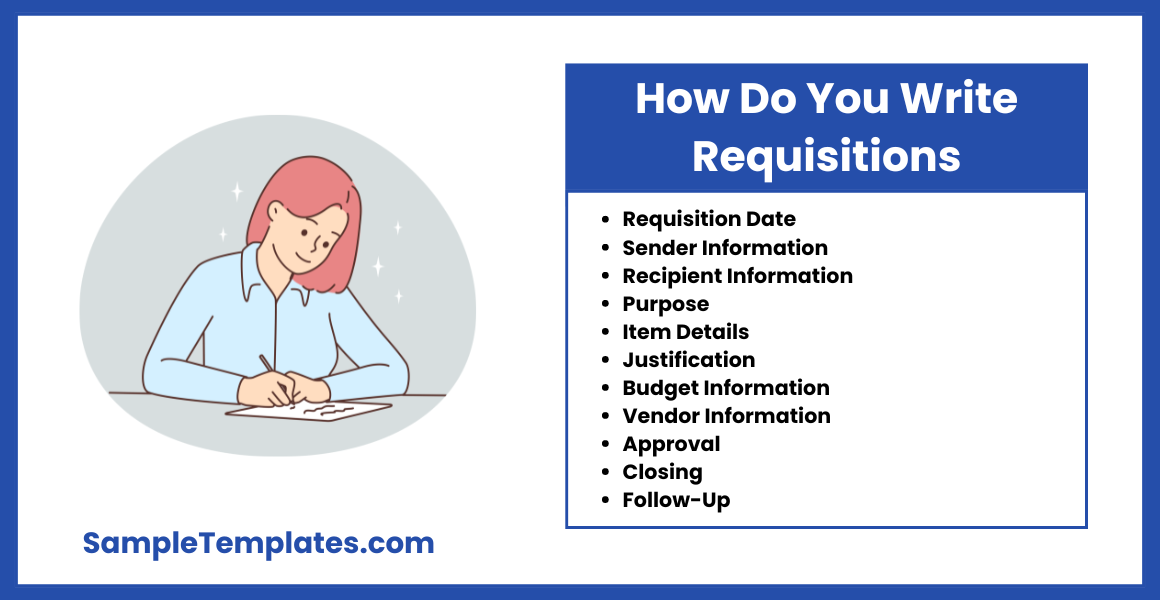
Writing a requisition involves communicating a need for goods or services within an organization. Here’s a guide to help you write an effective requisition:
1. Heading: Start with a clear heading that includes the word “Requisition.” Add the date to indicate when the requisition is made.
2. Sender Information: Include your name, position, department, and contact information. This helps in identifying the requester.
3. Recipient Information: Specify the recipient’s details, including the name, position, and department. This could be the person in charge of procurement or the appropriate authority.
4. Purpose: Clearly state the purpose of the requisition. Specify whether it’s for purchasing goods, services, or both. Be concise and specific.
5. Item Details: Sample List each item or service you are requesting. Include essential details such as quantity, description, specifications, and any other relevant information. If applicable, provide item codes or part numbers.
6. Justification: Explain why the items or services are needed. Include information on how they will contribute to the success of a project, department, or the organization as a whole.
7. Budget Information: If there’s a specific sample budget for the requisition, mention it. This helps the procurement team in managing expenses and staying within budget constraints.
8. Vendor Information: If you have preferred vendors or suppliers, include their details. Otherwise, leave this section blank for the procurement team to find suitable suppliers.
9. Approval: Include a section for the necessary approvals. This might involve obtaining approval from your supervisor, department head, or any other relevant authority.
10. Additional Instructions: Provide any additional instructions or specific requirements for the procurement team. This could include delivery instructions, preferred delivery dates, or any other relevant details.
11. Closing: End the requisition with a closing statement expressing gratitude for consideration. Include your signature and date.
12. Follow-Up: After submitting the requisition, be proactive in following up to ensure it’s processed in a timely manner. Communication is key in the procurement process.
11. Appointment Requisition Letter Format
Target Audience for the Requisition Letter Samples
The sample requisition letters are aimed towards individuals as well as firms of every type and functionality because these writing letters pervade all types of business operations by the very virtue of its nature as a tool for formal interrogation about the particular state of affairs which concerns the operations on which the requisitioning enterprise depends. Hence, knowing how to compose a good requisition letter is an important aspect of conducting myriad transactions in the business world as a whole.
We have a huge range of sample requisition letters that can be completely edited according to your will, you just need to select the template that serves your purpose and merely type in the information as and where required. You can also use the templates to prepare your letters. You can also see the Response Letter Samples.
If you have any DMCA issues on this post, please contact us.
FAQS
What is the purpose of a requisition letter?
The purpose of a requisition letter is to formally request goods or services within an organization, providing details like item specifications, quantities, and justifications for the procurement process.
How does a requisition work?
A requisition initiates the procurement process by formally requesting necessary items or services. It sample outlines specifications, quantities, and justifications, facilitating efficient internal communication and resource allocation.
Who typically initiates a Requisition Letter?
A Requisition Letter is typically initiated by department heads, managers, or employees within an organization who identify a need for specific resources, items, or services.
Is a Requisition Letter the same as a Purchase Order?
No, a Requisition Letter and a Purchase Order serve distinct purposes. The Requisition Letter is a request for items or services, while a Purchase Order is an official document authorizing the purchase.
Can a Requisition Letter be submitted electronically?
Yes, a Requisition Letter can be submitted electronically through various means such as introduction email or online systems, streamlining the process of requesting items or services.
How is a Requisition Letter different from a Requisition Form?
While both serve the purpose of requesting goods or services, a Requisition Letter is typically a formal written request, whereas a Requisition Form is a structured document used for the same .
In conclusion, a well-crafted requisition letter format is a vital tool in the procurement process, facilitating clear communication and ensuring efficient fulfillment of resource needs.
Related Posts
Resignation Letter for Medical Samples & Templates
Letter of Intent Samples & Templates
Letter of Intent for a Job Samples & Templates
Lease Proposal Letter Samples & Templates
Letter of Inquiry Samples & Templates
Character Reference Letter Samples & Templates
Claims Letter Samples & Templates
Response Letter Sample & Templates
Follow Up Letter Samples & Templates
Sample Project Proposal Letter Templates
Donation Letter Samples & Templates
Addressing a Formal Letter Samples & Templates
Grievance Letter Samples & Templates
Sample Sponsor Thank You Letter Templates
Sample Letters of Request
